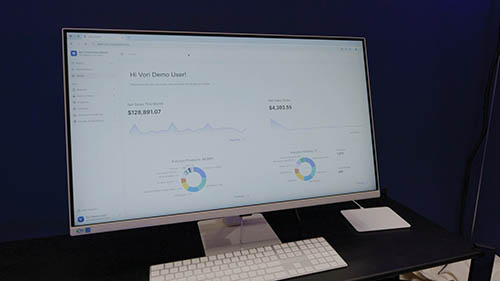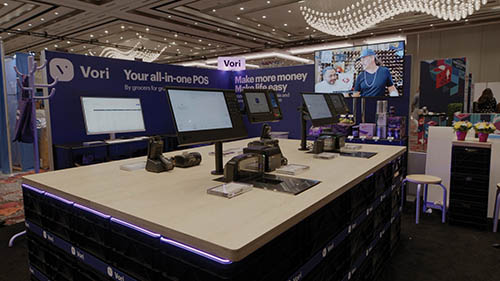— By Tremaine Kirkman —
Revolutionizing retail facilities — specifically grocers — with AI solutions.
Independent grocery retail facilities, such as neighborhood markets, corner stores, family-run supermarkets and bodegas, fuel the heart of our communities. They bring fresh, often local, goods to consumers; offer diverse product selections; and foster a sense of connection while contributing significantly to local economies. However, as large retail chains with extensive resources dominate the grocery market, smaller and independent grocery retailers face mounting challenges, compounded by minimal adoption of advanced technology due to price and capability mismatches.
From managing inventory to navigating pricing complexities and optimizing supply chains, staying competitive can often feel like a near-impossible task. This is where advanced AI (artificial intelligence) solutions step in, transforming how retail facilities operate and empowering them to thrive in today’s modern economic climate.
Challenges in Retail Facility Management

Retail facilities in certain sectors have undergone significant growth over the past decade. They now represent a substantial share of the market — in grocery, 33% (according to a recent National Grocers Association study) — fueled by consumers’ interest in personalized shopping experiences, unique product offerings, and the COVID-19 pandemic. However, facility managers must juggle a variety of challenges to maintain this growth, including the following key areas:
Inventory Management
Efficient inventory management is critical for profitability. Running out of popular items frustrates shoppers, while overstocking leads to wasted resources. Traditional inventory tracking systems often rely on manual processes prone to errors, inefficiencies and guesswork.
Pricing Adjustments
With rising operational costs, such as inflation and fluctuating tariffs, retail facilities must constantly adjust pricing to protect slim profit margins. Manually updating back-end systems, invoices or physical price tags adds operational inefficiencies and increases the risk of errors that could cost revenue.
Supply Chain Complexities
Many independent retailers lack access to the robust logistics networks that larger competitors rely on. This makes them vulnerable to supply chain disruptions and limits their flexibility in optimizing costs.
Resource Limitations
Legacy point-of-sale (POS) systems, understaffing and outdated tools add additional strain on retail facility leaders and staff, taking attention away from driving growth and engaging customers.

Unchecked, these challenges don’t just impact efficiency and profitability; they can threaten the survival of the independent retail sector. In grocery, as the retail landscape becomes further digitally integrated and more competitive, innovative AI solutions provide an answer by tailoring powerful retail tools to the specific use cases of independent grocers, regardless of size or format. For example, The Market at Edgewood in Palo Alto, California, repurposed two full-time employees from pricing coordination to sales and customer marketing after implementing an AI-driven pricing management solution.
How AI Can Revolutionize Retail Facilities
AI technology has moved beyond just being a tool for corporate retail giants. Today, cutting-edge AI solutions are accessible for even the smallest of retail facilities. Take Ava’s Downtown Market & Deli in Mountain View, California — a single location owner/operator grocery store with eight employees, empowering them to optimize operations, manage wholesale distributors and vendors effectively, and fuel shopper loyalty without overburdening existing labor. Here’s how AI addresses the core issues faced by grocery retailers:
Optimized Inventory Management
AI’s ability to analyze historical sales data, consumer demand trends and external factors like seasonal changes is transforming inventory management. With these insights, grocers can optimize stock levels, reduce excess inventory and ensure popular items are always available. This not only minimizes waste, saving thousands of dollars monthly, but it improves customer loyalty. For instance, many retailers have implemented AI systems to automatically forecast demand and anticipate peak periods, avoiding costly overstocking while reducing instances of stockouts.
Simplified Pricing Structures
AI simplifies pricing by flagging vendor cost changes, automating price updates and monitoring profit margin targets. Advanced tools can recommend ideal price adjustments and even update digital price tags with a single click. These innovations save time and eliminate manual errors, allowing staff to focus on higher-priority tasks like creating an engaging in-store experience.
Efficient Supply Chain Management
AI-powered supply chain tools provide predictive insights to help retail facilities anticipate disruptions and create cost-effective replenishment orders. By leveraging AI logistics solutions, grocers and their wholesale suppliers can reduce supply chain inefficiencies and ensure grocery store shelves remain consistently stocked with the right products.
Enhancing Customer Experience
AI isn’t just about improving back-end operations; it also impacts front-end customer engagement. Some systems analyze buying patterns to personalize product recommendations or create tailored promotions. This helps small retailers provide the one-on-one type of customer service that larger, big box competitors typically can’t deliver.
Creating a Level Playing Field for Independent Retailers
Perhaps the most dynamic benefit of AI is its ability to level the playing field. Independent retail facilities can now access AI-powered tools that were once exclusive to corporate chains. These include real-time analytics, automation and integrated workflows, enabling retail managers to make smarter, data-driven decisions faster.
By leveraging AI platforms, grocers can streamline their operations, reduce costs and focus on building stronger relationships with their local customer base. This modern, customer-first approach ensures independent retailers stay relevant, profitable and competitive in the long term. Grocers now using tools such as digital loyalty programs and turnkey mobile marketing campaigns, are seeing net sales increase by as much as 20%+ year-over-year.
Driving Sustainability via AI
Retail facilities play a critical role in promoting sustainability, and AI tools provide a pathway to reducing waste and supporting eco-friendly practices. The U.S. grocery sector alone wastes around 160 million tons of food annually. Grocers using AI can minimize this waste by tracking inventory in real time, identifying slow-moving stock and redistributing surplus items to the areas where they are needed most.
Take Carver Neighborhood Market, a small grocery serving a food desert region in Atlanta. After adopting AI inventory systems, Carver Market significantly increased efficiency, redirected resources to community support initiatives and reduced waste — demonstrating the social and environmental ripple effect AI can create in retail facilities.
Future of Retail Facility AI
AI’s role in retail facilities is evolving rapidly. The future will bring advanced capabilities such as predictive ordering based on hyper-personalized consumer behavior, AI-driven customer communication and even deeper integrations with advanced logistics technology.
Retail facilities will benefit from tools that not only streamline operations but also allow businesses to anticipate customer preferences and adapt quickly to market changes. Whether through improved efficiency, waste reduction or high-quality customer experiences, facilities equipped with AI technology are poised to lead the way into the future.
New Era for Retail Facilities
Retail facilities, and particularly independent grocers, are much more than businesses. They are integral parts of their communities and economy, providing essential services while fostering relationships and workforce opportunities. By adopting advanced AI tools, retail facilities can drive profitability, reduce inefficiencies and create meaningful and scalable customer experiences.
The future of retail facilities lies at the intersection of technology and customer care. AI is no longer a luxury reserved for industry giants. Now, smaller retailers can use these tools to thrive in a competitive market and continue enriching the communities they serve.
— Tremaine Kirkman a co-founder and the chief product officer of Vori, the first and only modern grocery operating system created to meet the needs of independent grocers. Vori’s fully integrated point-of-sale system and store management platform is backed by AI and designed to empower small business owners and democratize access to food supply. Learn more at www.vori.com.

